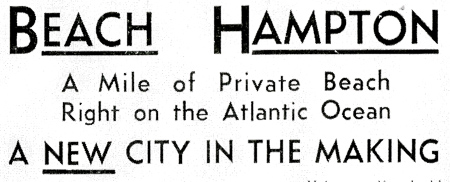
“Schef, as Alfred A. Scheffer was known to his close friends and relatives, married my mother’s sister Theresa. As a hard-working architect, Schef loved his profession with a passion few of us experience in life.
After many years of producing modest houses in the 1970s, Schef was commissioned to design some large-scale residences and projects.
Yet, the Scheffer work that demands special attention is this collection of modest Beach Hampton cottages, for it was there that this architect left his mark with structures of masterful composition and proportion, full of exquisitely simple details.”
— Gregory W. Zwirko, Architect.
~~~~~~~~~~~~~~~~~~~~~~~~~~~~
Beach Hampton, Amagansett
Architect Alfred Scheffer’s Beach Hampton Houses, 1941 – 1965
~~~~~~~~~~
A Selection of Photographs & Plans,
with Text from Robert Hefner’s
Alfred A. Scheffer’s Beach Hampton Houses, 1941 to 1965
Courtesy of the author.
———
Beginning in the 1920s, Richard B. Allen began buying dune land just east of the settled area of the village of Amagansett. By 1936, the R.B. Allen Corporation owned a vast tract extending one mile along the ocean from present-day Beach Lane to Napeague Lane and running inland to Bluff Road and Montauk Highway, comprising more than 200 acres. Mr. Allen set out to develop a community of beach houses for the middle class, which he called Beach Hampton.
——————
Beach Hampton, ideally located at the extreme eastern end of Long Island, on one of the finest shores of the broad, cool Atlantic, yet less than three hours from New York City, is not just another real estate development: it is an ideal, a vision, a dream that we have made come true.
Here, if you will, awaits you a new world of happiness!
— Excerpt from ‘Eastward to the Sea, The Romance of Beach Hampton’ . A 24-page booklet, 1937, mailed to prospective purchasers responding to advertisements placed in newspapers in New York City and on Long Island.
——————
~~~~~~~~~~~~~~~~~~~~~~~~~
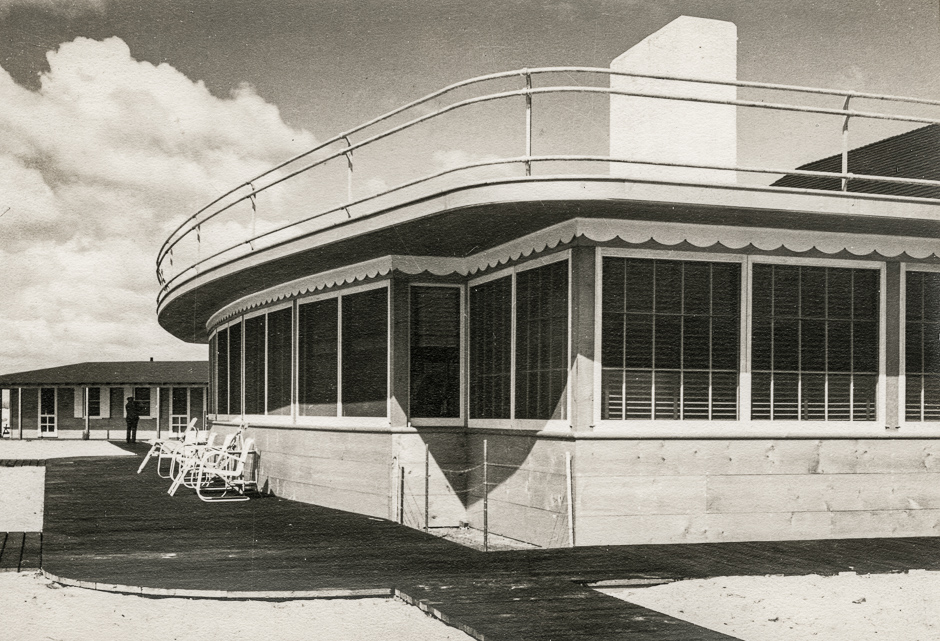
Barbour Beach Hampton Club — financed by NYC restaurateur Ella Barbour and designed by the architectural firm of Scheffer & Tichy — was constructed on Marine Boulevard in the spring of 1938, and swept away on September 21st by the Hurricane of 1938.
The Barbour Beach Hampton Club, with its bowed front, with a band of windows over flush pine siding, streamlined tubular steel railing around an overhanging sundeck, was one of the earliest modernist buildings on Long Island. Ella Barbour described her restaurant as being “a conservative modern type of architecture” and as having an interior of “extreme simplicity.” This was a cautious embrace of modernism that reflected what Ella Barbour, Alfred Scheffer, and Lester Tichy saw as appropriate for a beach-front restaurant in the Hamptons.
 Barbour Beach Hampton Club — aftermath of the 1938 Hurricane,
Barbour Beach Hampton Club — aftermath of the 1938 Hurricane,
which came ashore on September 21st.
~~~~~~~~~~~~
Four months later, R.B.Allen asked Alfred Scheffer to design a new clubhouse to replace Ella Barbour’s restaurant. A rendering titled ‘Proposed Beach Hampton Club’ was completed in March, 1939. The rendering shows a two-story building with a traditional Colonial Revival design featuring a two-story columned portico and a broken-scroll pediment over the entrance, reflecting the taste of Richard B. Allen. This club was never built.
~~~~~~~~~~~~~~~~~~~~~~~~~
Cape Cod Beach House Design, 1941
Early in 1941 Alfred Scheffer began designing a Cape Cod beach house with a modernist aesthetic. Beach Hampton was developing as a colony of Cape Cod cottages by the shore. Scheffer took this traditional form and made it into a low, streamlined, and informal beach house that would fit into the dune landscape. Ella Barbour built two for the 1941 season. The design reflects the characteristic Barbour aesthetic for a traditional form rendered with extreme simplicity and having a modern air….
Ella Barbour built a house for her daughter and son-in-law, Catherine and James Perkins, on Hampton Lane, and house for herself and her husband, Philip Barbour, across the way. The Perkins House had living spaces on the first floor only, while the Barbour House had two small bedrooms under the gable.
~~~~~~~~~~~~~~~~~~~~~~~~~
House No. 101, Beach Hampton, L.I.
Elevation Plans for the one-story Cape Cod beach house built for Catherine and James Perkins in 1941.
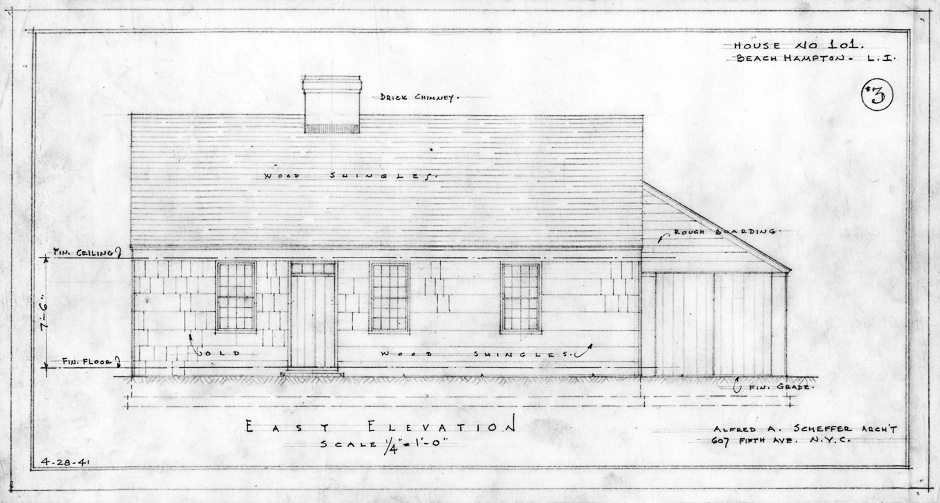
The spare exterior features long shingles, a batten door in a narrow board frame with a four-light transom, and a broad frieze board that doubles as a head casing for the front door and the windows.
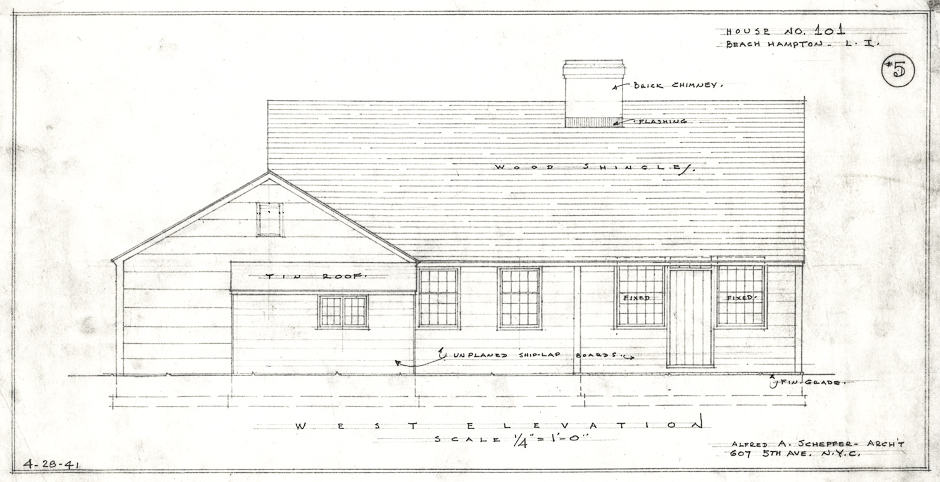


——————
Catherine and James Perkins House, 1941, Beach Hampton

Alfred Scheffer took the aesthetic of the Barbour Beach Hampton Club and applied it to a Cape Cod cottage. Although having a traditional exterior appearance, this design was influenced by the values of modern architecture that became part of Scheffer’s world through his associations with Ella Barbour and Lester Tichy….
The Perkins house has rooms only on the first floor. A compact plan is arranged under a complex roofline that from the front is deceptively simple. With an eye to keeping the house low and to reducing volume, Scheffer employed a variety of forms, different roof pitches and changing eave heights to create a ground-hugging beach house. Eight foot eaves and a steep roof slope give the front a traditional appearance while a more shallow rear slope and eaves at seven feet extend the interior space for the kitchen and bedrooms.
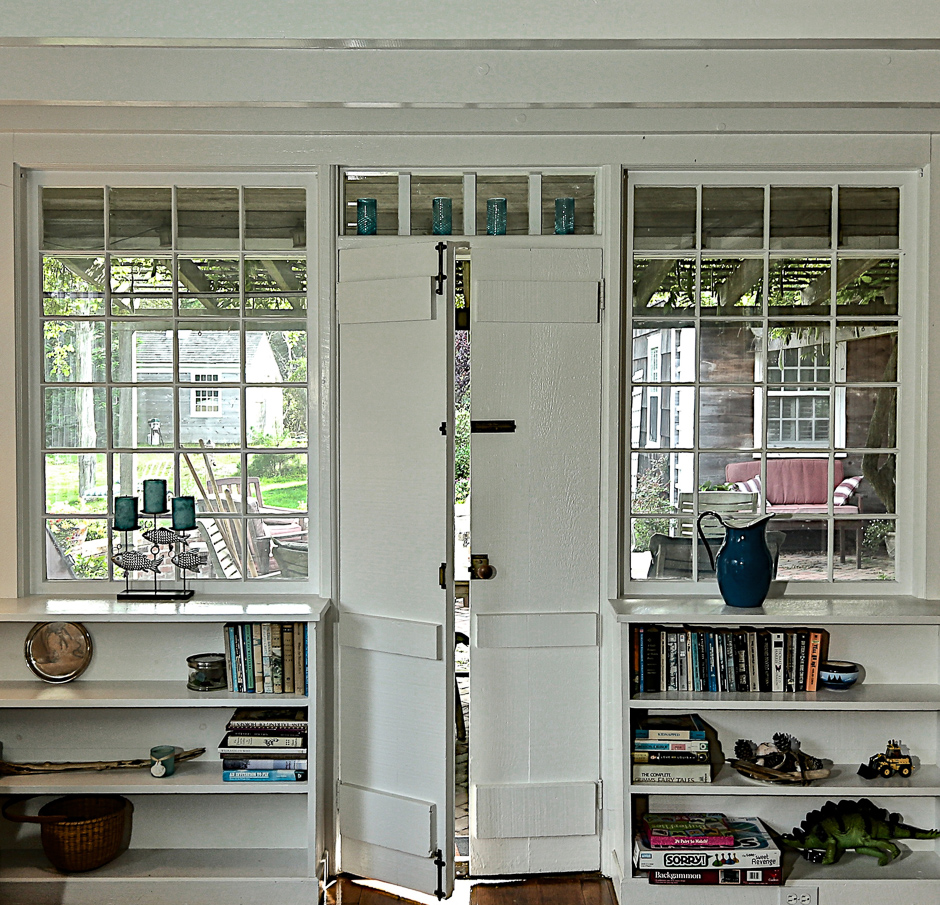
The masterpiece of clean and simple, yet elegant, detailing is the west wall of the living room where a door that opens to a terrace is flanked by windows and built-in bookcases. The doorway is fitted with double batten doors, each only 15 inches wide, that open against the bookcases and, when open, virtually disappear. The door and adjoining window share a fir framing stud as the exposed jamb for each. The opposite window jambs are also exposed wall studs covered only by the pine wall sheathing. The windowsill is the top shelf of the bookcase. Scheffer put as much thought into this light and clean composition as he had in his earlier finely-detailed interiors of suburban houses.
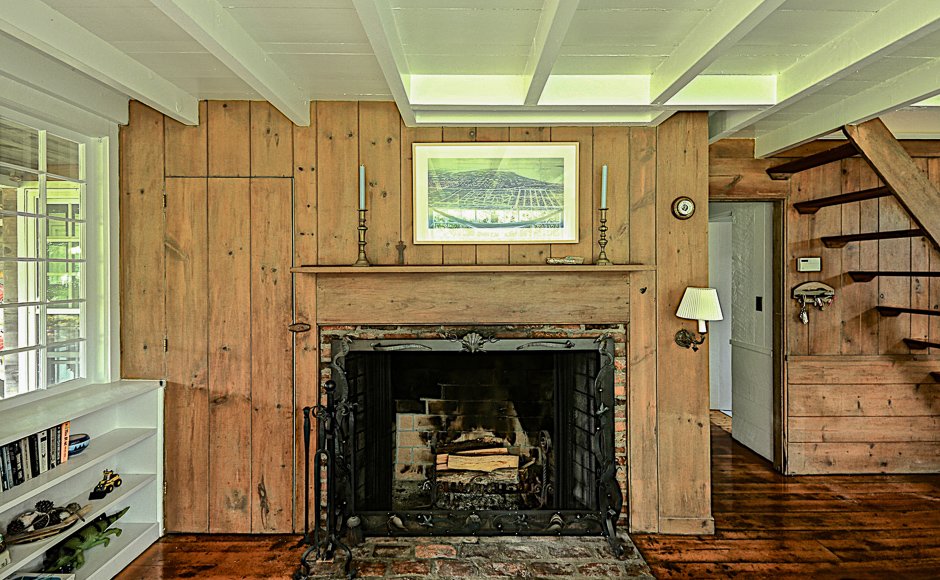
The proportions of the rooms were carefully planned. The living room, 14 x 21 feet to plan, has the proportions of the golden rectangle. The low headroom (7 feet, 9 inches) under the joists contributes to the intimate sense of scale. The living room has a floor of wide pine boards. The walls are covered with knotty, rough-sawn pine boards. Horizontal boards form a wainscot above which the boards are set vertically. A plain chair rail covers the joint between the horizontal boards below and the vertical boards above. In contrast to the rough boards elsewhere, the pine boards of the fireplace wall have a smooth, planed surface. The fireplace is picked out only by a horizontal board above the opening and a plain board mantel shelf. A blind closet door to the left of the fireplace has no knob, only a wooden turn button.

Louis Berg, who purchased the Perkins House about 1958, asked Alfred Scheffer to design a stairway for bedrooms he planned for the second floor. Scheffer adhered to the principle of “extreme simplicity” and drew a ship’s ladder. Pine treads extend from a pine stringer to cleats nailed to the wall paneling. There is no handrail.

Small bedroom, 10 feet square.
~~~~~~~~~~~~~~~~~~~~~~~~~
Ella Barbour House, 1941, Beach Hampton

The Barbour House, opposite the Perkins House, was of the same design but had two small bedrooms and a bath on the second floor. Alfred Scheffer and Ella Barbour showed the greatest restraint possible with a Cape Cod house by forgoing dormers and relying only on a single window in each gable to light the bedrooms. Ella Barbour covered the exterior of her house with the same horizontal pine weather-boards used on her 1938 restaurant.
R.B. Allen published a promotional map of Beach Hampton for the summer of 1941 showing the two Barbour Houses and a rendering of a proposed new beach club. With the attack on Pearl Harbor on December 7, 1941, and the declaration of war that followed, the beach at Amagansett became militarized.
On January 15, 1942, the German U-boat 123 torpedoed the British tanker Coimbra 27 miles off the beach and residents of Southampton reported seeing the fire. By April 1942, a U.S.Army camp was established on the beach at Napeague and the Coast Guard was maintaining a beach patrol from the Amagansett Coast Guard Station at the end of Atlantic Avenue. Seaman John Cullen, patrolling east from the Amagansett Coast Guard Station, just after midnight on June 13, 1942, encountered George John Dasch, one of four Nazi saboteurs who had just disembarked from U-202 and rowed ashore at Beach Hampton. With suspicions raised, Cullen rushed back to the station to report that Germans had landed.

Detail of south wall of the living room. The exposed wall stud between the window and door is the jamb for both, with beaded stops nailed to it. The wall plate, ceiling joists, and the pine flooring above are all exposed as interior finish. The door of pine boards has plain battens with no bead or chamfer.
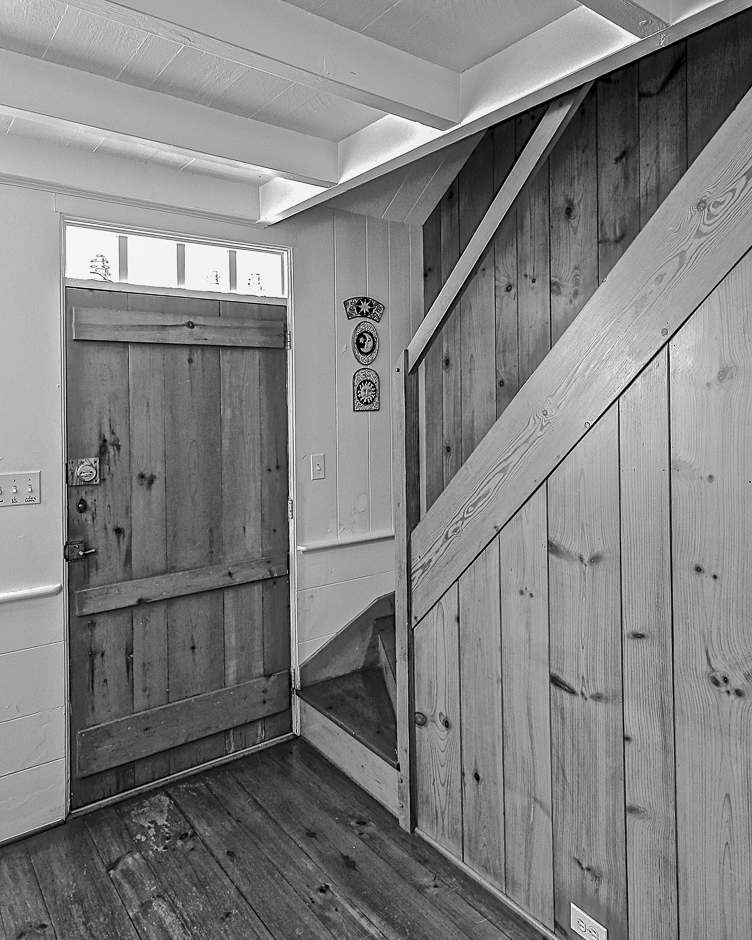
The handrail is a pine board housed into the newel post and pegged.
~~~~~~~~~~~~~~~~~~~~~~~~~
Alfred A. Scheffer House, 1949
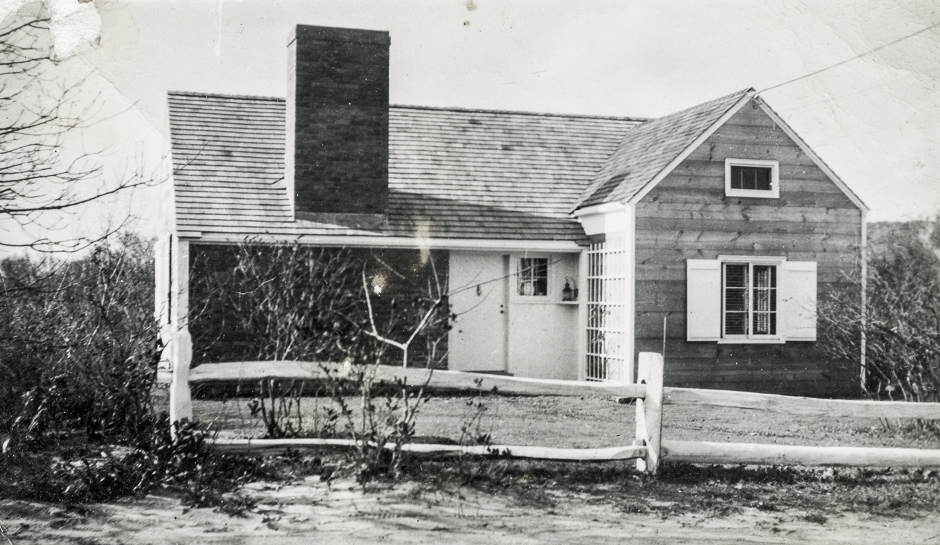 Alfred A. Scheffer House, 1949, in a photograph from the 1950s: damaged by fired and demolished, 2010.
Alfred A. Scheffer House, 1949, in a photograph from the 1950s: damaged by fired and demolished, 2010.
For himself and his bride, Terry, Scheffer drew an entirely new design embodying the architectural themes that he cared most about. Here he employed the timber framing and expansive brick that had appealed to him since he started his library in 1921 with many books on early English houses.
Scheffer’s house was even smaller than the 1941 Cape Cod model, with a first floor of 680 square feet containing a living room, kitchen, bedroom, and bath. An upper floor had a small bedroom and a balcony overlooking the living room.
Beginning with Beach Hampton’s requisite Cape Cod form, Scheffer placed a lower cross gable just beyond the doorway. The main gable, which provided a cathedral ceiling over the living room, had a ridge at 16 feet while the projecting cross gable had a ridge at 15 feet under which, in a sleight of hand, Scheffer fit a lower and upper bedroom. The upper bedroom had six feet of headroom under the ridge, enough to enter the room and dive left or right into one of the single beds.
While Scheffer used shiplap pine siding for most of the house, he indulged in a brick wall on the front facade that extended above the eaves in a wide and tall chimney stack. An entry recess between the brick wall and the projecting gable had white painted vertical boards and a masthead lantern perched on a pine shelf beneath a little four-light sash that took the place of a transom light for the low doorway. The beach house character was enlivened with a rose trellis on the projecting wing.
The interior featured the same mix of materials that Scheffer favored. The living room had a brick floor and the wide brick chimney breast of the exterior was also exposed inside. Walls are finished with pine boards and minimal trim that Scheffer employed in the Ella Barbour cottages.
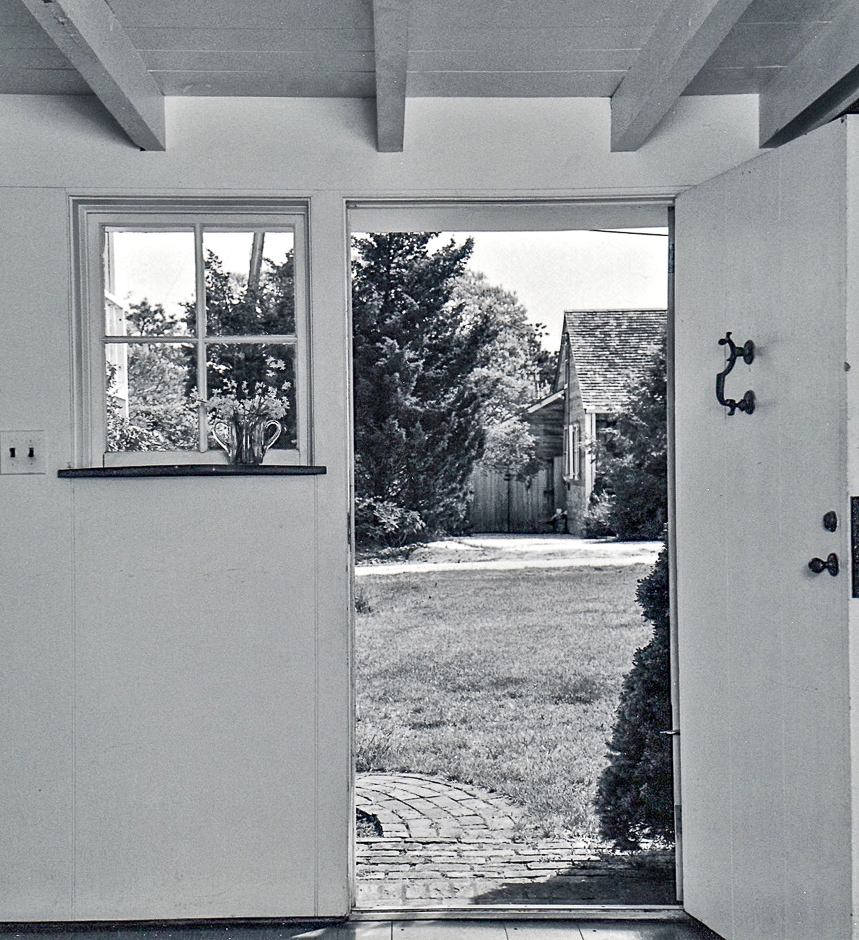
View from the living room through the entry door.
——————–
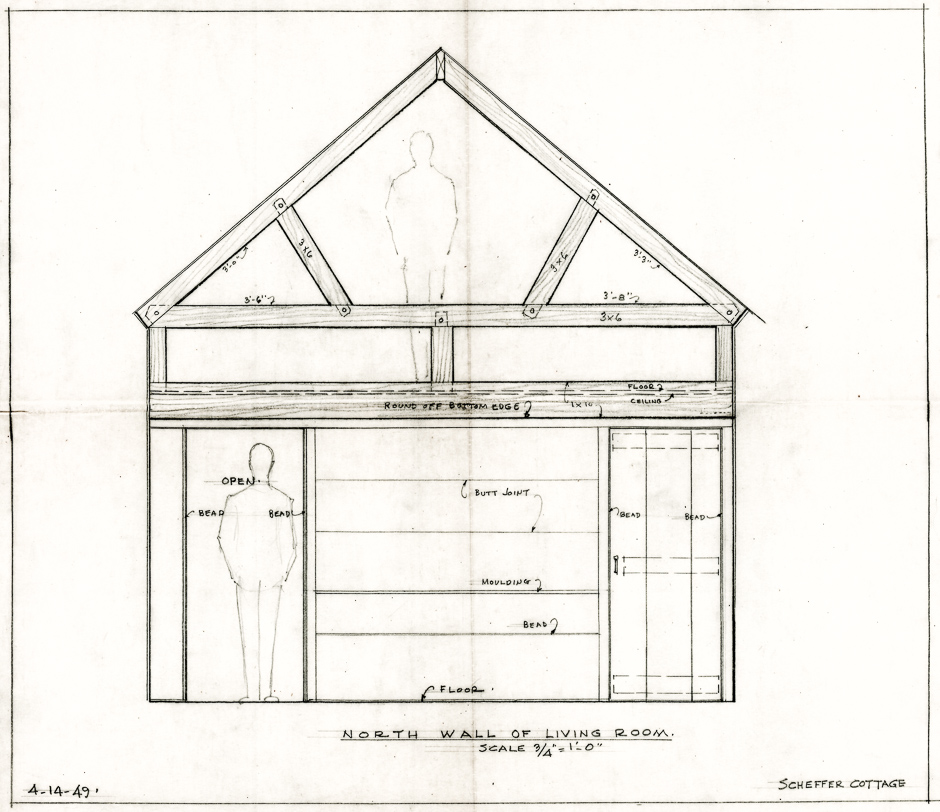
Courtesy of Zwirko and Ortmann Architects, P.C.
The drawing of the north living room wall shows the doors to the kitchen and bedroom and the timber truss at the balcony. The sketched figures illustrate Scheffer’s desire to keep the volume low with doorways only 6 feet and 2 inches high and headroom of only seven feet beneath the ridge pole at the balcony.
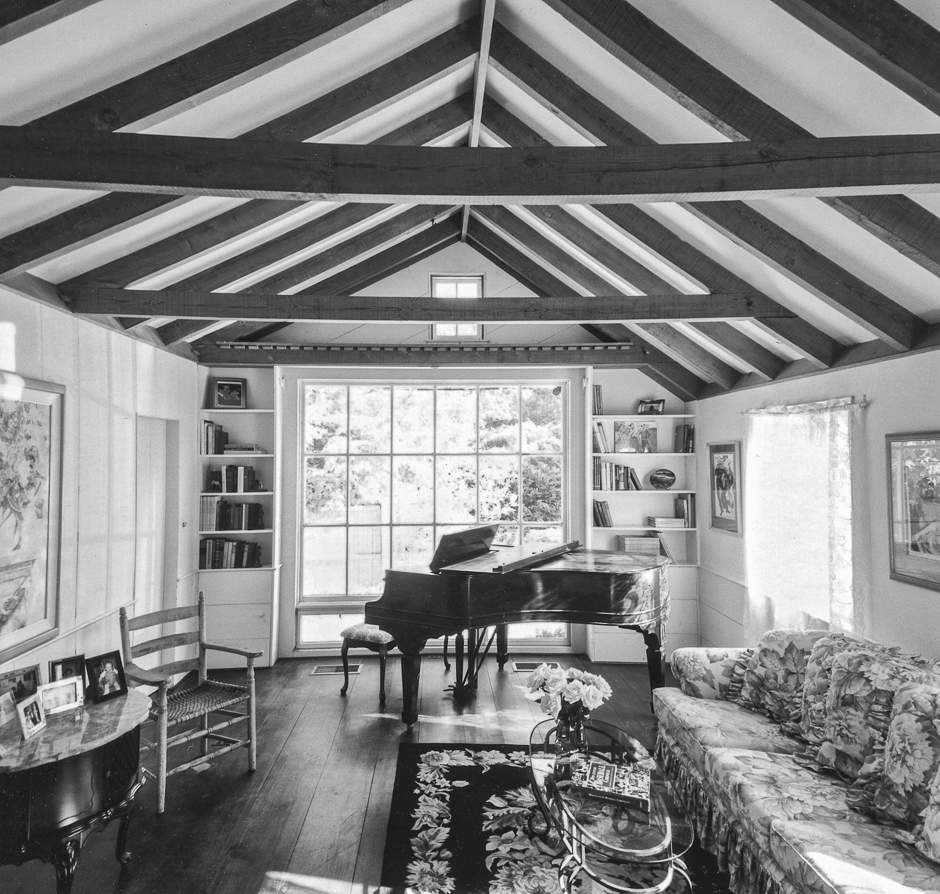
Addition to the original cottage.

Exterior view of addition.
~~~~~~~~~~~~~~~~~~~~~~~~~~~~~~~~~~~~~~~
MODEL HOUSES OFFERED FOR SALE
—————
R.B. Allen Corporation Model House No. 1, 1950, Beach Hampton
With Alfred Scheffer now the resident architect at Beach Hampton, Richard B. Allen turned to him to develop some low-cost cottage designs. Allen wanted to take advantage of the federal mortgage insurance program for World War II veterans….Scheffer developed five related plans….Advertisements in the newspapers and mailings of brochures invited prospective buyers to “Come Out This Weekend” to inspect the model home built on Gardiner Drive. Land and a house could be had for $ 4,950. With financing from the R.B. Allen Corporation, payments were to be $ 25 per month.
The beach houses ranged from 560 square feet to 920 square feet and all were designed with an eye to cost. All five designs shared the theme of a pitched-roof main block surrounded by flat-roofed or shed-roofed wings. The main block contained a living room with cathedral ceiling while the kitchen and bedrooms were in the wings. Scheffer provided the main living area with a sense of spaciousness with a high ceiling, but for sleeping, bathing, and cooking he kept the ceiling and the volume as low as possible to create an overall streamlined form.
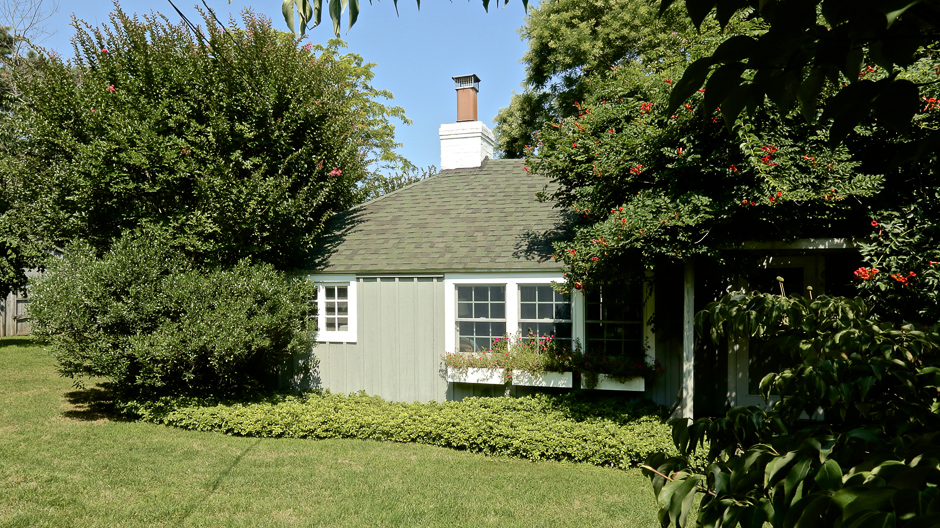
Model House No. 1: This beach house, with a living area of 680 square feet, has a living room under a low hip roof with shed-roofed and flat-roofed wings pinwheeling out on three sides. The living room flows into a dining alcove under one lean-to while the kitchen is in a lean-to on the opposite wall. A flat-roofed wing across the third wall contains two bedrooms, each 10 feet square in plan. Scheffer strove to bring these beach houses as close to the ground as possible. The ridge is 13 feet above grade while the eaves are between seven feet and eight feet. Roofs had wood shingles while the walls are covered with a combination of horizontal shiplap siding and vertical board-and-batten siding.
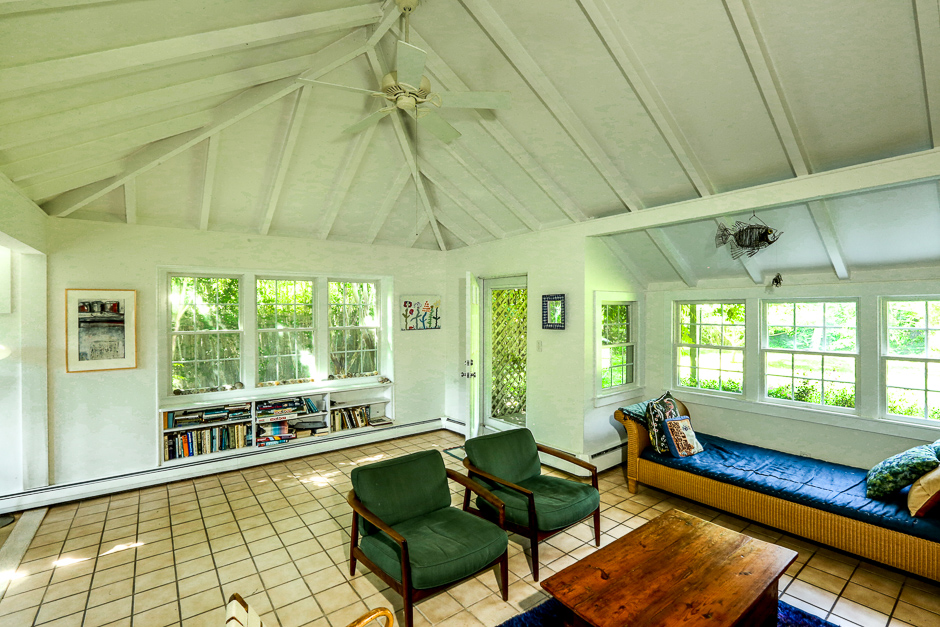
The interior is finished simply. Floors are asphalt tiles set on the concrete slab. Walls are covered with fir plywood giving the appearance of horizontal boarding with a bead ploughed to simulate the joint between boards. The pine rafters and the pine roof sheathing are exposed in the ceiling…Both floor tiles and plywood for the walls reduced the cost, and there were few labor-intensive details.
~~~~~~~~~~~~~~~~~~~~~~~~~
R.B. Allen Corporation Model House No. 1A, 1950, Beach Hampton

~~~~~~~~~~~~~~~~~~~~~~~~~

R.B. Allen Corporation Model House No. 2. This beach house with 720 square feet of living area and a living room with cathedral ceiling under the gable, a kitchen in the lean-to, and two small bedrooms in the flat-roofed wing.
~~~~~~~~~~~~~~~~~~~~~~~~~
Scheffer Barn, 1955
With a successful practice developing in East Hampton, Scheffer purchased a lot on the corner of Wyandanch Lane and Montauk Highway and built a house there on speculation. This project set the stage for much of his work and, like his own house, speaks clearly of the architecture that interested him the most.
Scheffer bought an early-19th-century barn that stood behind Miss Amelia’s Cottage on Main Street of Amagansett. The three-bay barn measured 28 by 32 feet in plan. A center wagon aisle, 10 feet wide, was flanked by 11 foot bays. The plate was at a height of 13 feet and the ridge was at 22 feet. This was the largest and tallest volume that Scheffer had yet worked with at Beach Hampton.
Just as he had previously interpreted the Cape Cod cottage, here Scheffer adapted his barn to the popular suburban form of the split-level home. This approach also allowed him to sink the barn into the dune to lower the overall mass. The main level comprised the wagon aisle and the north bay. Here Scheffer placed the entry and stairway, living room, and kitchen. The living room extended across the two bays and was 21 feet wide by 17 feet deep. Following the theme of the 1950 R.B.Allen houses, the living room was the only space with a high ceiling….
Scheffer stacked two levels of bedrooms in the north bay. From the entry hall, stairs led down to two rooms on the lower level and up to a master bedroom. The two-level bedrooms, each 10 feet square in plan, had typically low ceilings with 6 feet, 8 inches of headroom to the ceiling joists. The master bedroom, 10 by 17 feet in plan, had a generous seven feet of clearance to the timber frame of a tray ceiling extended into the gable roof of the barn.
This was a typical Scheffer design in which bedrooms and a kitchen with low ceilings are arranged around a spacious living room.

The Scheffer Barn was damaged by fire and demolished in 1955. In this 1955 photograph, Alfred Scheffer and a mason are laying a brick walkway. Photo credit: Collection of Gregory Zwirko.
The Scheffer Barn is distinctive for the use of a historical timber frame and for the abundant brickwork found inside….The open timber frame allowed Scheffer to use brick with greater impact than ever before. A chimney rose through the timber frame with the brickwork exposed. From the broad chimney breast in the living room, Scheffer filled in the barn frame with brick set between timber studs in the manner of English half-timbering.
———————– Sistership in Water Mill ———————–

Alfred Scheffer used the plans for his barn to design a “sistership” in Water Mill, 1967. This photograph shows the stairway leading up and down from the entry. In the lower level hall is the miniature fireplace that was also in the Scheffer Barn.

This photograph of the living room shows the same chimney breast and half-timbering that was in the Scheffer Barn.
~~~~~~~~~~~~~~~~~~~~~~~~~

A PORTFOLIO OF OTHER
ALFRED A. SCHEFFER HOUSES AT BEACH HAMPTON
~~~~~~~~~~~~~~~~~~~~~~~~~
Ody H. Lamborn House, 1950
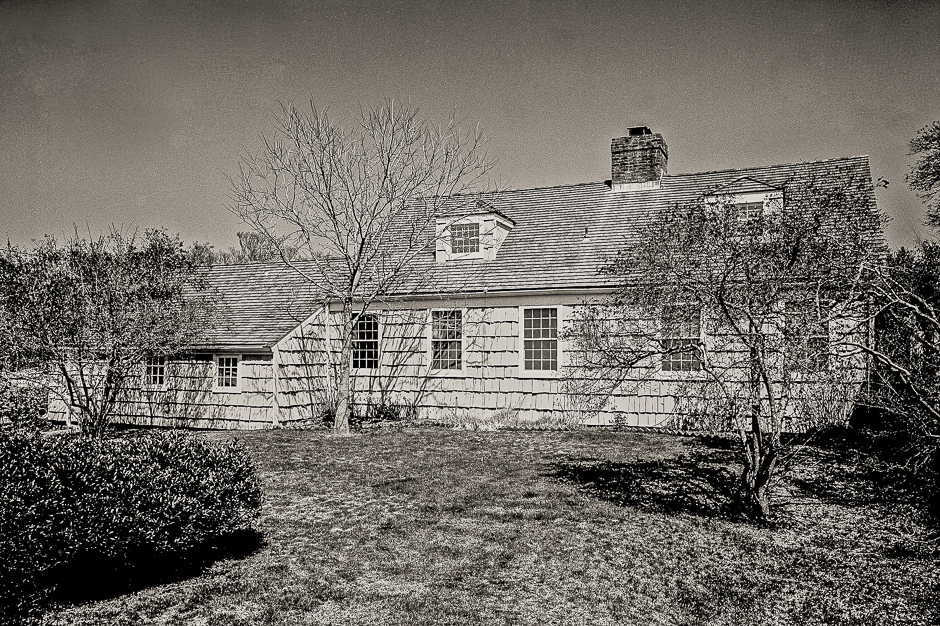
~~~~~~~~~~~~~~~~~~~~~~~~~
James Morrow House, 1951
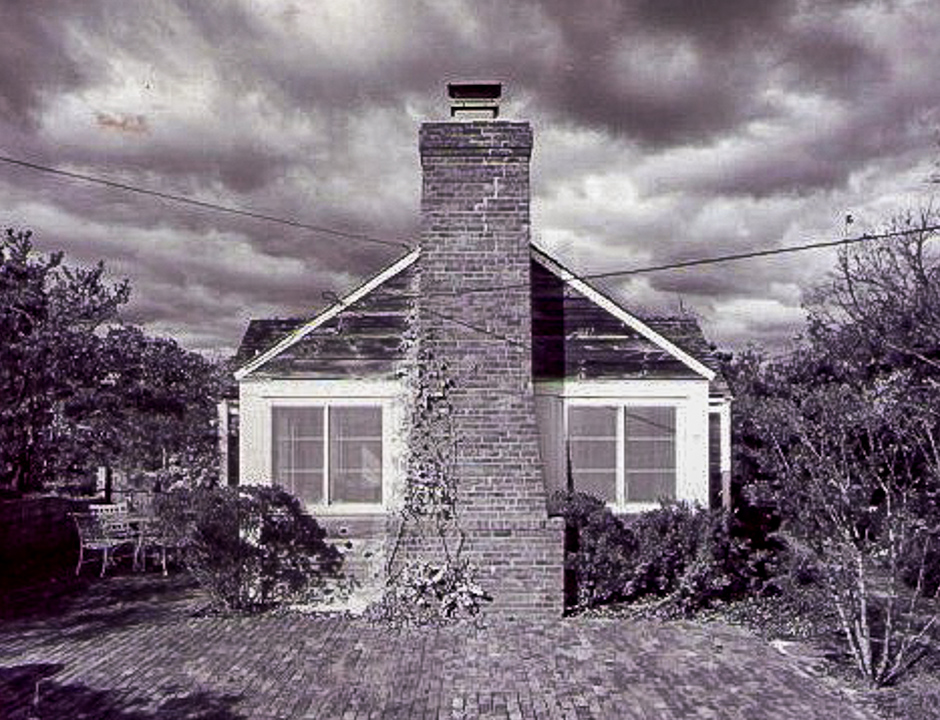
~~~~~~~~~~~~~~~~~~~~~~~~~
Sylvia Kohn House, 1955, Beach Hampton
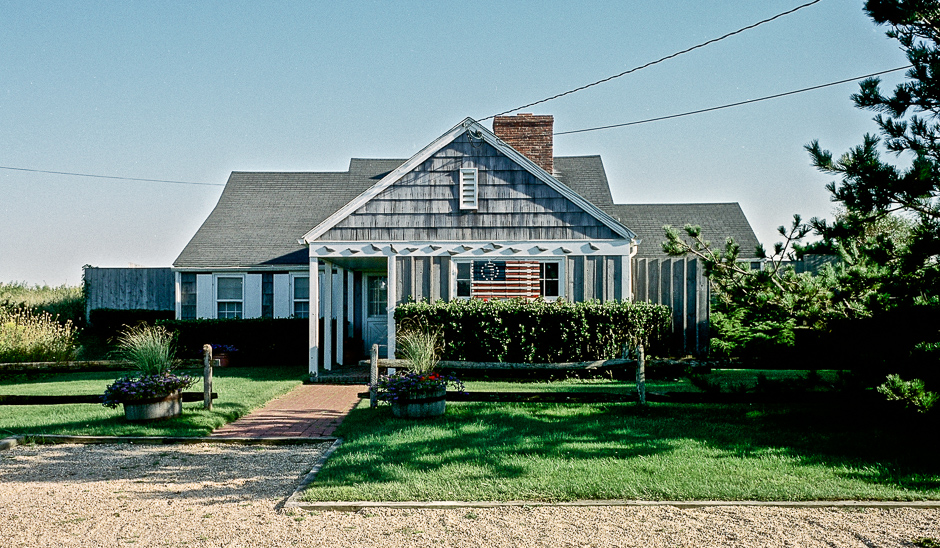
~~~~~~~~~~~~~~~~~~~~~~~~~
David C. Cory House, 1959, Beach Hampton

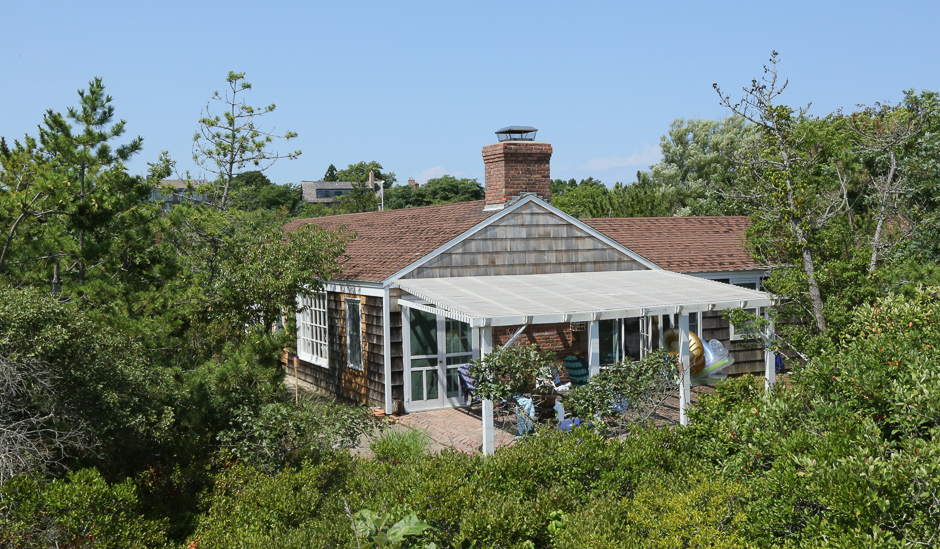
~~~~~~~~~~~~~~~~~~~~~~~~~
Arthur F. Becker House, 1962

~~~~~~~~~~~~~~~~~~~~~~~~~
Suzanne and Jerome Mangini House, 1965

~~~~~~~~~~~~~~~~~~~~~~~~~
Ian Gibson House, 1965
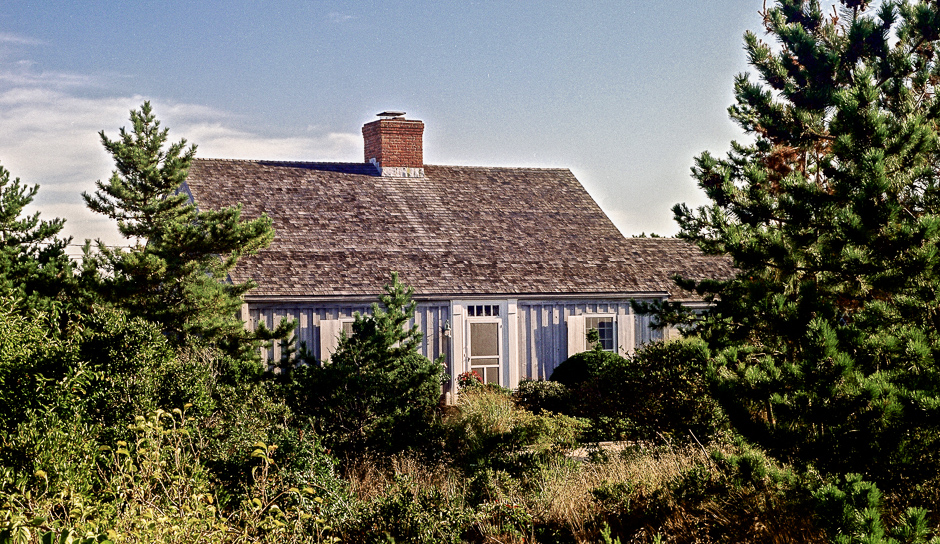
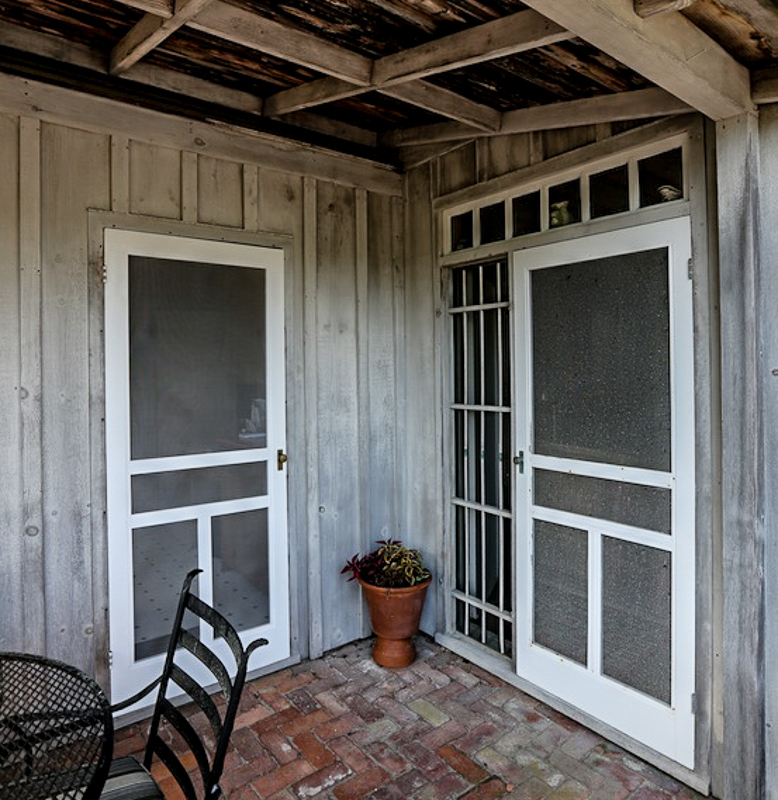
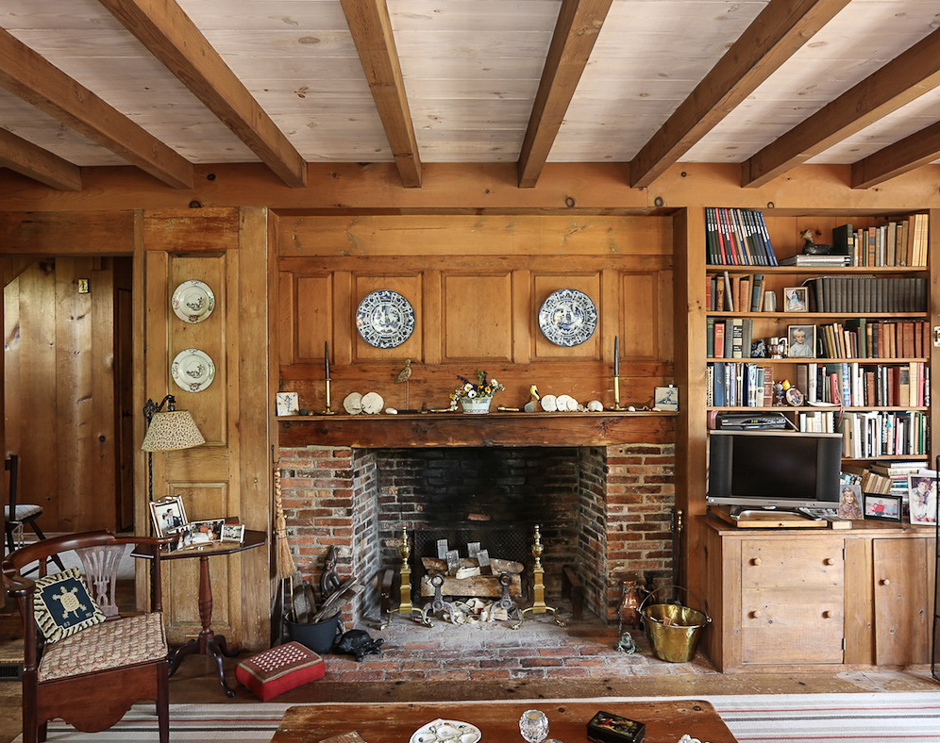
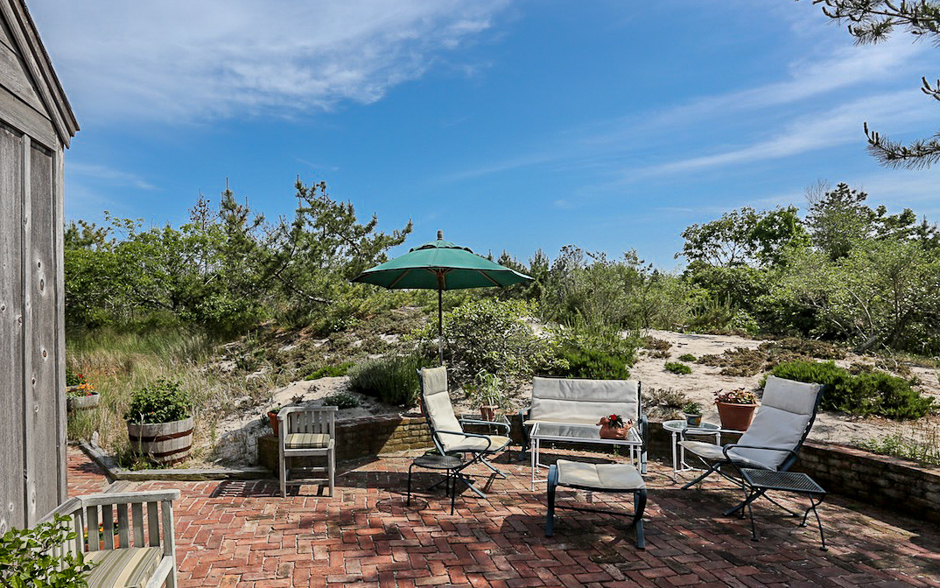
~~~~~~~~~~~~~~~~~~~~~~~~~
——————- Postscript ——————
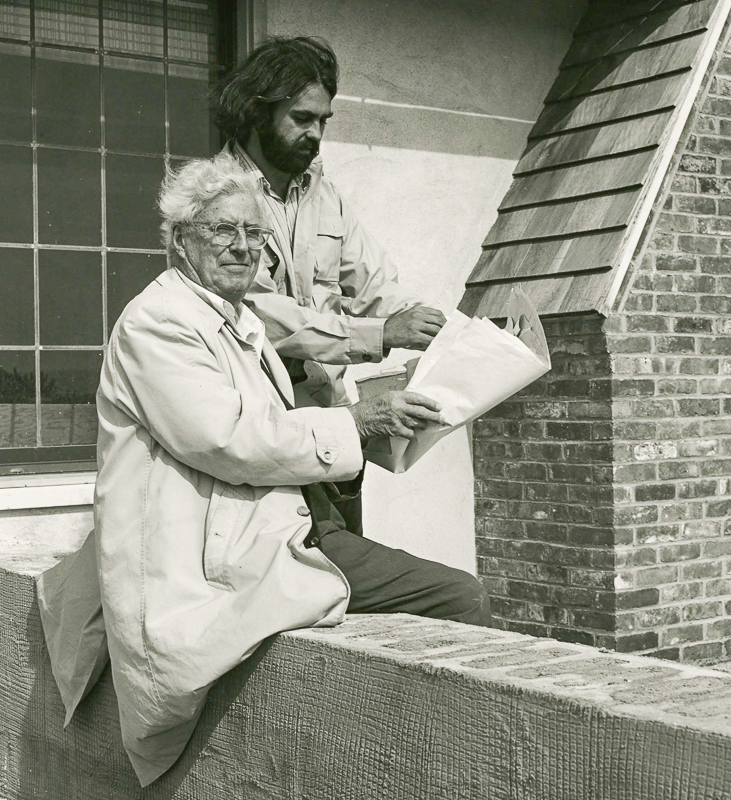
Alfred A. Scheffer and Gregory W. Zwirko with plans for a terrace at the Maidstone Club, 1974. Photo: John Spear / Collection of Zwirko and Ortmann Architects. P.C.
——————- Afterword ——————
This book is about Alfred A. Scheffer’s work at Beach Hampton, particularly his designs of the 1940s and 1950s. His work of this period is among his most innovative, as he joined other architects in creating something new, the weekend beach house. For Scheffer this meant treating a traditional form with a modern aesthetic, an overall informality, and, above all, keeping the volume low to the dune landscape. In the aftermath of the Great Depression and then of World War II, this was the era of the small house. Scheffer embraced the idea of economy and pared-down interior spaces and he stripped away all but the subtlest of decorative details. But his spare houses were more about aesthetics than budget….
When Schef died in 1976, at the age of 82, he was eulogized as the “dean of East Hampton’s architects” with more than 100 houses and public buildings to his name on the East End. A client, Thomas Griffith, wrote an insightful estimation of the architect: “Interiors were his pride; his own taste ran to cleanliness, natural materials, and simplicity. He loved wood and old brick, so most of his work, though not an imitation of the East End style, fitted beautifully in with it.” (1)
— Robert Hefner
(1) The East Hampton Star, August 26, 1976.
~~~~~~~~~~~~~~~~~~~~~~~~~~~~~~~
AAQ / Resource / Book / Link:

Robert Hefner’s Alfred A. Scheffer’s Beach Hampton Houses, 1941 to 1965 / Hampton Lane Press
~~~~~~~~~~~~~~~~~~~~~~~~
AAQ Portfolio / copy excerpts & select images from Robert Hefner’s book, courtesy of the author.
Photos, except archival, @ Jeff Heatley.
———————————————–
Visit: AAQ’s Portfolio — Montauk Association, Watercolors by Luquer, 1885
~~~~~~~~~~~~~~~~~~~~~~~~~~~~~~~~

Exclusive Portfolio
_______________________________________________________________________

